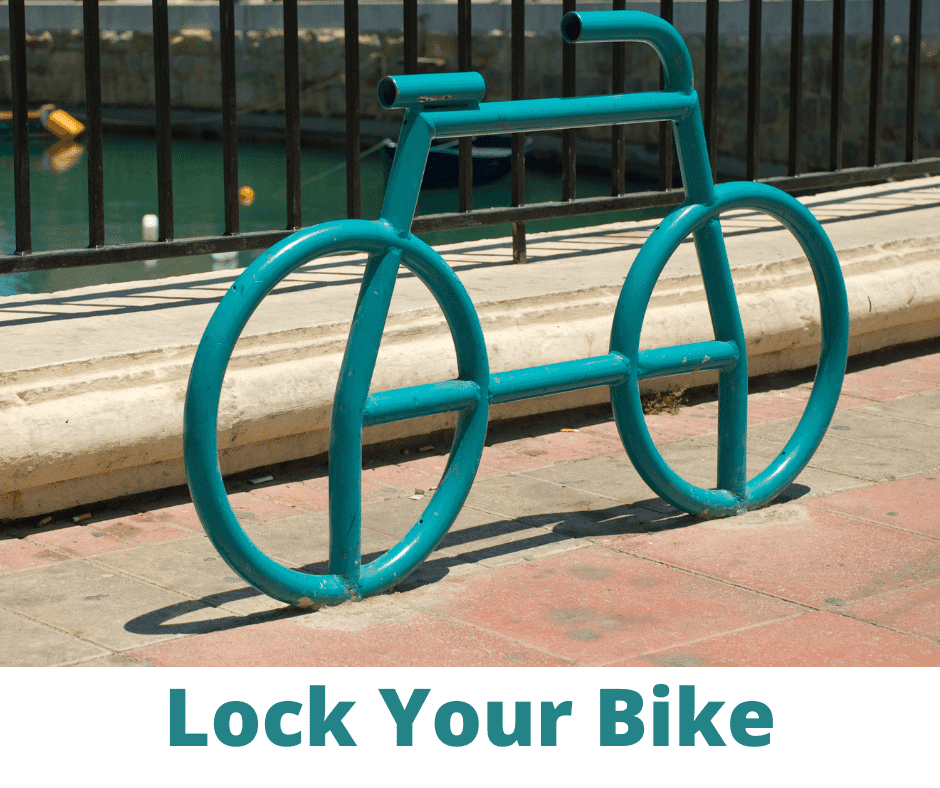To haul groceries efficiently on your bike, choose a sturdy bike with secure racks or baskets and weather-resistant bags. Plan your route with bike-friendly roads and pack light, keeping heavier items low and close to the frame for stability. Secure your cargo tightly and evenly distribute the weight to prevent shifting. Regular maintenance and safe riding techniques are essential. Keep your load balanced and safe, and you’ll find more tips to make your ride easier and safer.
Key Takeaways
- Choose a sturdy bike with appropriate racks or baskets designed for heavy loads.
- Distribute groceries evenly and low to maintain balance and stability during the ride.
- Secure cargo tightly using straps, bungee cords, or nets to prevent shifting or spills.
- Plan routes with bike-friendly roads, avoiding busy intersections and high-traffic areas.
- Regularly inspect and maintain your bike to ensure safety and reliability when hauling heavy loads.
Choosing the Right Bike and Accessories
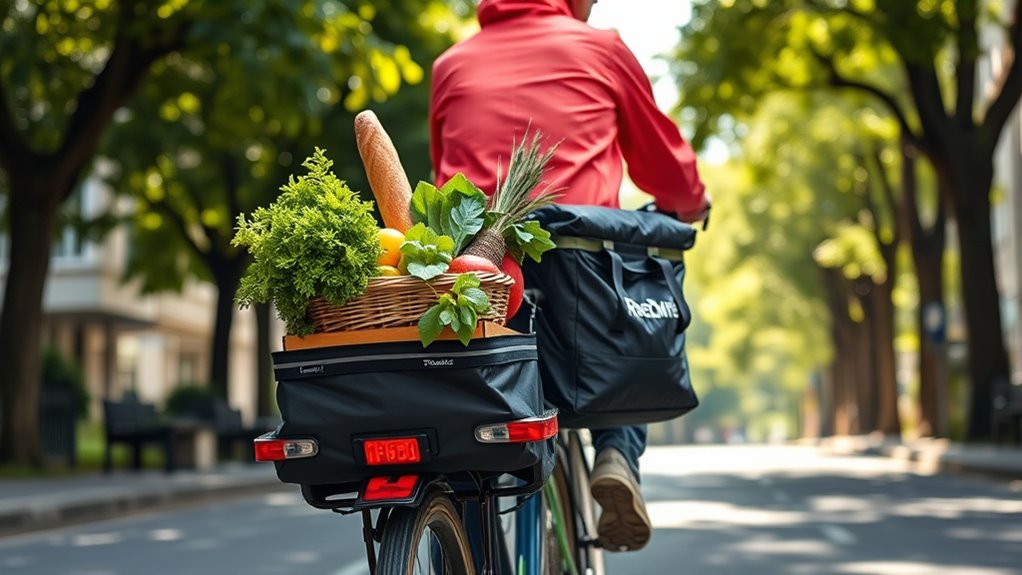
When selecting a bike for hauling groceries, it’s essential to choose one that can handle the load comfortably and safely. Start by considering the bike frame; a sturdy, durable frame ensures stability when carrying extra weight. Look for bikes designed for cargo or touring, as they often have reinforced frames and attachment points for racks. Additionally, pedal accessories can make a big difference—installing sturdy pedals with secure straps or clips keeps your feet in place, especially when traversing rough roads or inclines. Consider adding racks or baskets that attach firmly to your bike frame, providing ample space for your groceries. Using appropriate attachments can further improve load stability and distribution. Ensuring your bike has load capacity awareness features can help you stay alert to potential issues during your ride. Incorporating load management techniques can help prevent accidents and prolong the life of your bike. Combining a strong bike frame with reliable pedal accessories helps you maintain control, balance, and safety during every ride.
Planning Your Grocery Trip Effectively
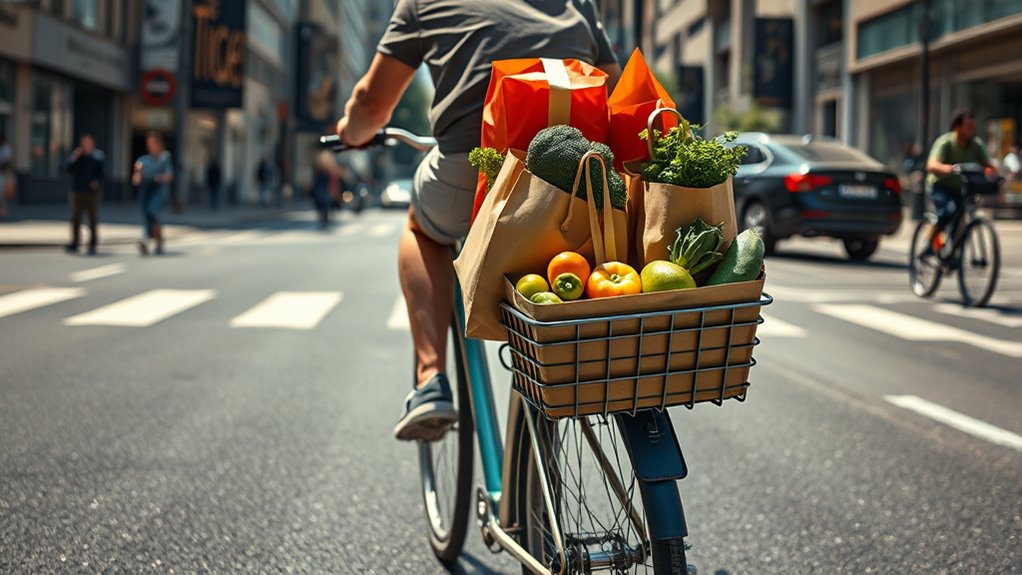
Effective planning is key to hauling groceries by bike without stress. Start by considering your route planning: choose the shortest, safest path, avoiding busy streets. Check the weather forecast ahead of time to prevent surprises like rain or strong winds that could complicate your trip. Here are three tips to stay on track:
Plan your bike route carefully and check the weather to make grocery trips smooth and stress-free.
- Map out your route in advance, prioritizing bike-friendly roads.
- Schedule your trip during favorable weather conditions, avoiding storms or extreme heat.
- Pack essential items like rain gear or sun protection depending on the forecast. Additionally, understanding the benefits of listening to classical music can help you stay relaxed and focused during your ride, making your grocery trip more enjoyable.
Selecting Secure and Appropriate Bags or Containers

Choosing the right bags or containers is vital to keeping your groceries secure and organized during your bike trip. Material selection plays a key role in durability, weather resistance, and weight. Look for sturdy, waterproof options like nylon or polyester for bags, and consider rigid containers made of plastic or metal for added protection. Container types vary from panniers and handlebar bags to trunk bags and baskets, each offering different advantages. Panniers attach securely to your bike and distribute weight evenly, while handlebar bags provide quick access. Make sure your chosen containers are compatible with your bike setup and can hold your groceries without shifting or spilling. Proper selection of materials and container types helps you maintain stability and avoid damage throughout your ride. Additionally, selecting efficient heat pump systems can improve energy management in your home, ensuring optimal climate control during all seasons.
Distributing the Load Evenly for Balance and Stability

Distributing the load evenly across your bike is essential for maintaining balance and preventing accidents. Proper load distribution ensures ideal weight balance, making your ride safer and more comfortable. To achieve this, focus on these key steps:
Distribute your load evenly for safer, more comfortable biking and better balance.
- Center the weight on your bike, placing heavier items low and close to the frame.
- Balance side-to-side by spreading groceries evenly between the left and right panniers or baskets.
- Adjust the load to keep the front and rear wheels evenly weighted, avoiding front or rear heaviness that can destabilize your ride.
- Be mindful of load stability to prevent shifting while riding, which can compromise safety and is similar to the importance of consistent pressure and finish quality in spray painting techniques.
- Regularly check your bike’s weight distribution during longer trips to ensure safety and comfort throughout your ride, especially since uneven loads can affect handling and ride quality.
Securing Your Cargo to Prevent Shifts and Spills

Have you ever experienced groceries shifting or spilling during a ride? To prevent this, it’s essential to secure your load properly. Use cargo straps to tightly fasten your bags or boxes to your bike’s rack or basket. Proper load stabilization keeps everything in place, reducing the risk of spills or loss of items mid-ride. Ensure straps are snug but not overly tight, so they don’t damage your groceries. Double-check that your cargo is evenly distributed and firmly anchored before you start pedaling. For extra security, consider using bungee cords or bungee nets in combination with straps. Taking these steps ensures your groceries stay put, making your ride safer and more efficient. Proper load stabilization is key to a smooth, spill-free grocery haul, especially when considering the benefits of load stabilization such as preventing shifting and spills.
Adjusting Your Riding Technique for Heavy Loads
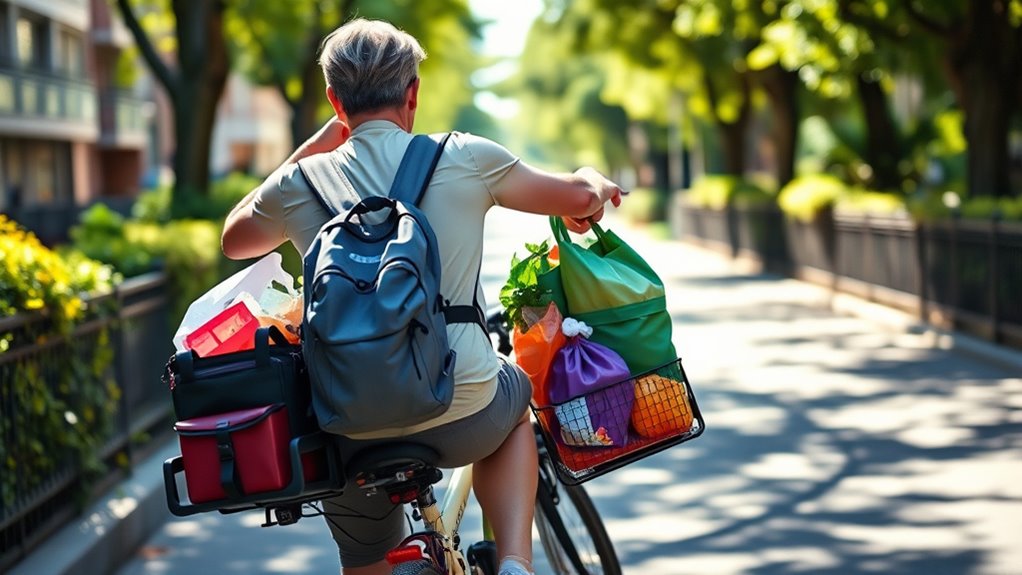
When riding with a heavy load, you’ll need to adapt your riding technique to maintain control and safety. Proper weight distribution is key—keep the load centered and low to improve stability. Adjust your riding posture by slightly leaning back to counterbalance the weight and avoid tipping forward. To optimize your technique, focus on these three tips:
- Shift your weight evenly over the bike to prevent wobbling.
- Keep your arms relaxed and elbows slightly bent for better control.
- Use smooth, deliberate movements to navigate turns and bumps, avoiding sudden shifts that could destabilize your load.
- Be mindful of rider stability, which is essential when managing heavy loads on your bike. Maintaining balance is crucial for safe cycling with substantial weight. Additionally, practicing these techniques regularly can help develop your confidence when hauling heavy loads. Incorporating bike handling skills into your routine can further improve your ability to manage challenging loads safely.
Navigating Traffic and Busy Streets Safely
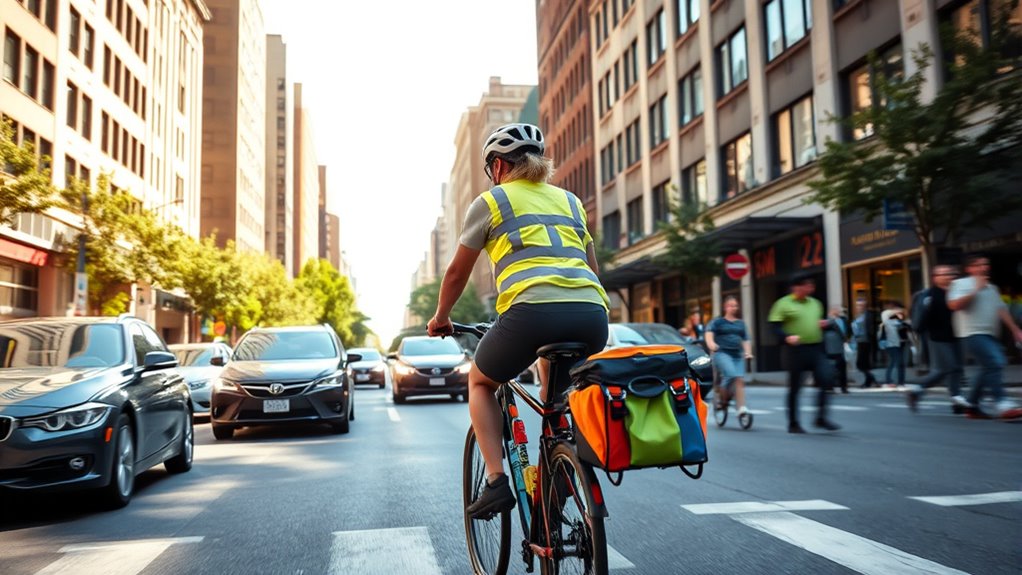
To stay safe on busy streets, always stay alert and make yourself visible to drivers. Choose routes with less traffic and clear bike lanes whenever possible. Being proactive helps you navigate traffic confidently and avoid accidents. Carrying multi-tools can also be helpful for quick repairs or adjustments during your ride. Additionally, wearing protective gear such as helmets and reflective clothing can significantly enhance your safety on busy roads, especially as traffic patterns can change unexpectedly. Incorporating AI-powered navigation apps can further assist you in choosing safer and less congested routes.
Stay Alert and Visible
Staying alert and visible is essential when maneuvering traffic and busy streets on your bike. Being aware of your surroundings helps you react quickly to hazards, while high visibility clothing makes sure drivers see you. To maximize your safety, consider these tips:
- Wear bright, reflective clothing to stand out.
- Use bike lighting—front and rear lights—to increase visibility, especially in low-light conditions.
- Stay focused on the road, avoiding distractions and checking your mirrors regularly.
- Research local traffic laws and bike safety regulations to ensure compliance and better understanding of your rights on the road.
- Recognizing the importance of proper visibility can significantly reduce the risk of accidents in busy traffic situations.
Use Safe Routing
Choosing the right routes can considerably improve your safety and efficiency when hauling groceries by bike. Start with route planning to identify streets with dedicated bike lanes or less traffic. Bike lanes provide a safer space away from vehicles, reducing the risk of accidents. When orienting yourself through busy streets, look for quieter side streets or residential areas that connect your route. Avoid shortcuts through high-traffic intersections or roads with limited visibility. Use navigation apps or local maps to find the safest paths, prioritizing routes that minimize exposure to heavy traffic. Always stay alert for turning vehicles and changing road conditions. By planning your route carefully, you’ll not only protect yourself but also make your grocery trips smoother and more enjoyable.
Maintaining Your Bike for Heavy Use
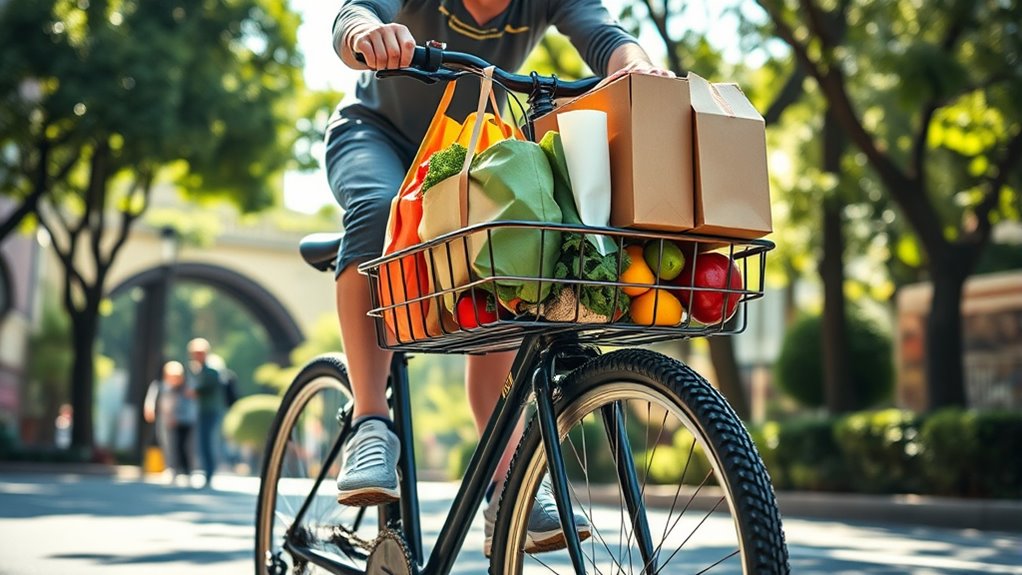
When you regularly haul heavy loads by bike, staying on top of maintenance is essential to keep your ride safe and reliable. Proper bike maintenance ensures your bike can handle the extra weight without issues. Focus on these key areas:
Regular maintenance keeps heavy loads safe and your bike reliable.
- Check tire inflation regularly to prevent flats and ensure smooth riding.
- Inspect brakes and gears for wear, making adjustments as needed.
- Lubricate chains and moving parts to avoid rust and ensure smooth operation.
Packing Light and Smart for Efficiency

To ride efficiently with a heavy load, packing light and smart is essential. Use lightweight gear to reduce overall weight, making your ride easier and less tiring. Focus on compact packing by choosing smaller, multi-purpose containers and avoiding bulky items. Organize your groceries in panniers or baskets to distribute weight evenly, which improves stability and balance. Place heavier items at the bottom and closer to your bike frame for better control. Limit the number of bags and ensure they’re securely fastened to prevent shifting. Prioritize essentials and avoid overpacking, so your bike remains maneuverable. Smart packing not only enhances your riding efficiency but also minimizes strain, letting you enjoy your grocery trip without unnecessary fatigue.
Practicing Safe Dismounts and Re-Loading Techniques
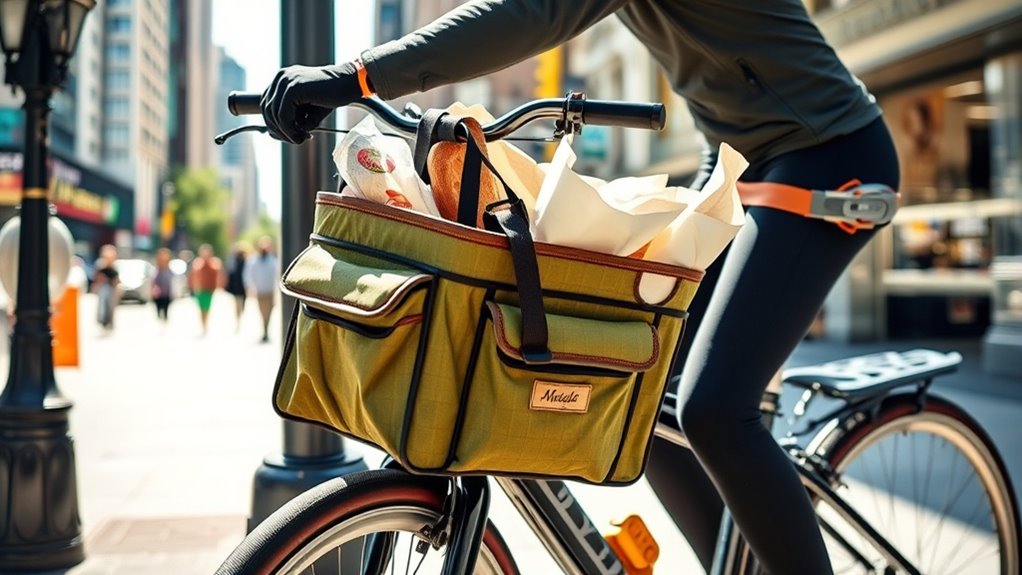
After packing your groceries efficiently, it’s important to master safe dismount and re-loading techniques to prevent accidents and protect your load. Properly executing safe dismounts helps you stay balanced and avoid falls. Re-loading techniques ensure your groceries stay secure during reattachment.
To improve your skills:
- Always dismount on a flat, stable surface, and come to a complete stop before getting off.
- Use both hands to gently lift and reposition your load, ensuring even weight distribution.
- Double-check fastenings and straps after re-loading to prevent shifting during your ride.
Practicing these safe dismounts and re-loading techniques minimizes risks and keeps your groceries secure, making your bike rides safer and more efficient.
Conclusion
By following these best practices, you transform your grocery runs into a seamless, eco-friendly journey. Think of your bike as a trusted steed, carrying more than just your groceries—it’s carrying your commitment to sustainability. With careful planning, proper securing, and a mindful ride, you’ll enjoy every trip as effortlessly as a breeze. After all, mastering these tips turns ordinary errands into an art form, making each ride a demonstration of your skill and care.




